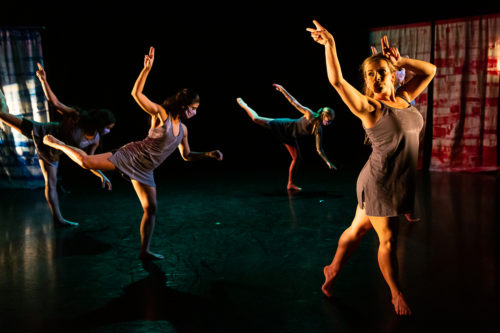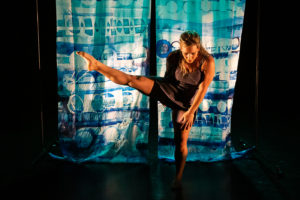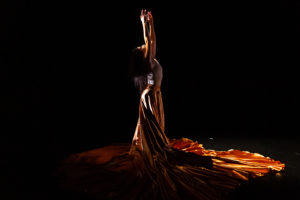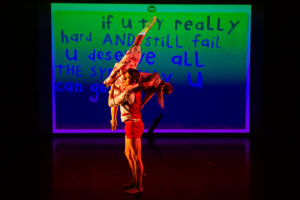Chapman Dance Provides a Welcome Sanctuary

From right to left, Liannet Madrazo, Roberta Paixao Cortes, Brit Wallis-McGrath, and Kristen Frankiewicz. Photo by Lynn Lane.
Standing in line at the MATCH box office; sliding into a stranger-adjacent seat while sending a wave to an acquaintance on the opposite side of the intimate theater; noting the hush as house lights dim; joining the eruption of applause for our host issuing welcomes and reminders — dancegoing is vaguely familiar. Even if we masked patrons with paperless programs are a little out of practice, sharing an experience in the dark still feels like coming home.
Teresa Chapman is home in this space, too. Like any good host, the choreographer lays out her favorite treats for guests. Her evening of past and present work, Sanctuary, is titled so to describe Chapman’s relationship with the studio and synergic process of dancemaking after so many months feeling deprived of it. Within the performance, she presents an energetic assortment of work that nods to the collective feelings of uncertainty and unrest of 2020 and 2021 without weakening morale.
In her intro, Chapman thanks her company of dancers, including Brittany Bass, Roberta Paixao Cortes, Jessica Luz Figeuroa, Kristen Frankiewicz, Lia Madrazo, Lindsey McGill, Davis Stumburg and Brit Wallis-McGrath, for taking a risk to make and revive work in an ongoing pandemic. The performers all wear masks — I don’t even notice this detail right away.

Kristen Frankiewicz pictured. Photo by Lynn Lane.
The top card in Chapman’s deck of dances, Exquisite Corpse, is extracted from a 2013 evening-length collaboration with visual artist Lucinda Cobley, who was in the house opening night. Cobley’s monochromatic paintings on silk feature geometric shapes of irregular pattern and intensity, evoking an embossed shroud. Hung from two flats, the ensemble shifts and repositions these throughout the piece, disappearing and reappearing as the sawing strings of Uakti’s composition and the movement patterns of Chapman’s work escalate to a sudden finish.
Chapman’s antithetic followup is another art-inspired work, Stop Copying Me, which she buffers with a musical interlude — a Gary Jules-like rendition of Tears for Fears’ Mad World — affectively and existentially performed by vocalist and dancer Jessica Figeuroa. A response to the 2018 Cary Liebowitz Museum Show exhibit at the Contemporary Arts Museum Houston, Stop Copying Me, is a colorful and occasionally cheeky trio featuring Frankiewicz, Wallis-McGrath and Stumburg against a backdrop of Liebowitz’s text-based pop art. Costumer Ashley Horn Nott is at her flouncy best, charming us with a bright palette of 50s-esque fashion.

Roberta Paixao Cortes pictured. Photo by Lynn Lane.
The highlight of the second act is a new work, Memento, which Chapman dedicates to her mother-in-law. Again, Knott’s costumes shine as the curtain opens revealing Cortes, Figueroa and Frankiewicz each standing bare-backed in a large pool of their own jewel-toned skirt. The image is striking but over a little too soon as one by one the dancers shift or twist their bodies, diminishing their circle of color. Just as the mental question of whether or not the dancers will be able to move from these spots surfaces, the women lift their skirts and run. They give one another and their trailing skirts wide berth before tossing fabric away from their bodies to make room for more movement. Turning with lifted arms as the skirts spiral around them, the dancers create a moment that is as captivating today as I imagine it might have been for audiences of early modern dance pioneer and theatrical innovator “La Loie” Fuller, who was known for her next-level skirt dancing.
Memento’s original score by guitarist and composer George Heathco (also in attendance), creates a rich audio tapestry for the work that gradually emerges from somewhere deep within the solar plexus as it develops into melody. On opening night, it appeared mistimed lighting cues may have robbed us of a few final seconds of Memento and the evening’s final work, Don’t Touch My Planet. Mildly disappointing, as Nicolas Jackson’s lighting design was otherwise fluid and effective throughout, this was a small distraction in an otherwise engaging evening of dance that also featured a trio of brief vignettes featuring the voice and music of Tom Waits and two screendance solos crafted by Chapman for dancers Bass and McGill during the previous year’s period of quarantine and distancing.

Davis Stumberg & Brit Wallis-McGrath. Photo by Lynn Lane.
Thinking back to the “before times” — before the COVID-19 pandemic — we might have been likely to long for restful or quiet alone time, a respite from the people or activities that hustle and bustle us. If nothing else, the pandemic has been a reminder, as it has for Chapman, that the presence and energy of community can also be restorative and bring us peace. Highlighting the full-bodied, space-eating, long-limbed movements that are indeed Chapman’s signature, the program closer, Don’t Touch My Planet, is inviting and fun despite the warning of its title. It ends the evanescent and communal experience of a night of dance on a high note. Welcome home.



Recent Comments